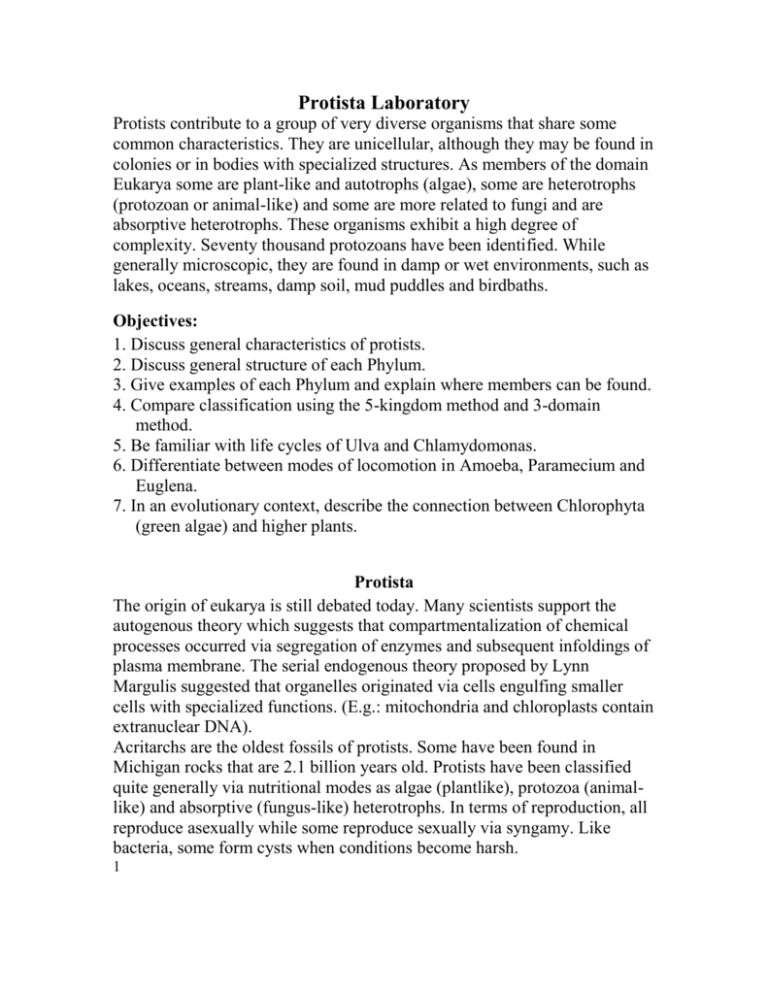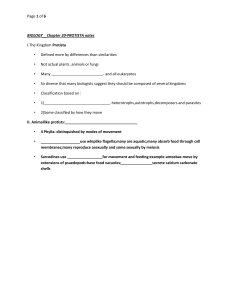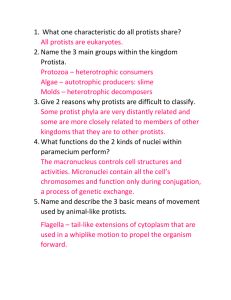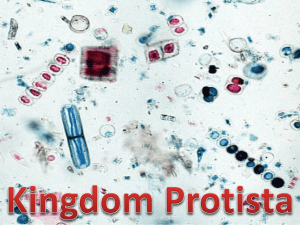Protista Laboratory
advertisement

Protista Laboratory Protists contribute to a group of very diverse organisms that share some common characteristics. They are unicellular, although they may be found in colonies or in bodies with specialized structures. As members of the domain Eukarya some are plant-like and autotrophs (algae), some are heterotrophs (protozoan or animal-like) and some are more related to fungi and are absorptive heterotrophs. These organisms exhibit a high degree of complexity. Seventy thousand protozoans have been identified. While generally microscopic, they are found in damp or wet environments, such as lakes, oceans, streams, damp soil, mud puddles and birdbaths. Objectives: 1. Discuss general characteristics of protists. 2. Discuss general structure of each Phylum. 3. Give examples of each Phylum and explain where members can be found. 4. Compare classification using the 5-kingdom method and 3-domain method. 5. Be familiar with life cycles of Ulva and Chlamydomonas. 6. Differentiate between modes of locomotion in Amoeba, Paramecium and Euglena. 7. In an evolutionary context, describe the connection between Chlorophyta (green algae) and higher plants. Protista The origin of eukarya is still debated today. Many scientists support the autogenous theory which suggests that compartmentalization of chemical processes occurred via segregation of enzymes and subsequent infoldings of plasma membrane. The serial endogenous theory proposed by Lynn Margulis suggested that organelles originated via cells engulfing smaller cells with specialized functions. (E.g.: mitochondria and chloroplasts contain extranuclear DNA). Acritarchs are the oldest fossils of protists. Some have been found in Michigan rocks that are 2.1 billion years old. Protists have been classified quite generally via nutritional modes as algae (plantlike), protozoa (animallike) and absorptive (fungus-like) heterotrophs. In terms of reproduction, all reproduce asexually while some reproduce sexually via syngamy. Like bacteria, some form cysts when conditions become harsh. 1 Protists are found in wet or damp environments. They inhabit soil, litter, oceans, ponds and lakes. Some contribute to plankton, the communities of organisms that drift or swim near the water surface. Phytoplankton constitutes the bases of both marine and freshwater environments. Symbiotic relationships exist between some protists and hosts, which may be classified as mutualistic, commensalistic or parasitic. Hosts may be higher organisms, such as vertebrates. The older five-kingdom method of classification is being replaced by a newer threedomain method of classification. The domains Bacteria and Archaea replace the kingdom Monera. Reclassification has occurred as more information has been made available which illuminates the biochemistry and further defines relationships of representative organisms. Bacteria and Archaea have been previously presented, thus we will focus on the classification of single-celled eukaryotic organisms formerly known as protista. The kingdom Diplomonadida includes organisms that lack mitochondria and have two nuclei. One example is Giardia lamblia, a diplomonad that causes intestinal distress and even death. The usual mode of infection is drinking water that contains human fecal material. Outbreaks of this disease sometimes occur in daycare centers or other places where good hygiene is in question. Examine prepared slides of Giardia and note the two nuclei in this flagellated organism. Draw Giardia. A newer kingdom, Parabasala includes organisms that lack mitochondria. A common example is Trichomonas vaginalis the source of a common STD. This disease can be harbored by males as well as females and is often silent (asymptomatic) in males. It is an interesting organism that possesses both flagella as well as an undulating membrane. 2 Another candidate kingdom, Euglenazoa, includes the pigmented and flagellated Euglena as well as another group, the kinetoplastids, a group of parasites that includes Trypanosoma (found on prepared slides only). Trypanosomes produce diseases such as sleeping sickness carried by the Tse Tse fly in Africa and Chagas’ disease, in South America. Euglena, generally autotrophic, is typically found in freshwater environs. They are autotrophs, which occasionally function as mixotrophs in the absence of light. Examine both prepared slides and living cultures if available in the laboratory. Living culture media will require a drop of Detain to slow the organism for viewing. (These slides must be then washed after viewing with soapy water as the Detain or Protoslo may be very viscous. Detain puts sets up a carbohydrate matrix which organisms become imprisoned in.) Draw a diagram of Euglena in the space provided. Candidate Kingdom Alveolata (a monophyletic group) includes dinoflagellates, ciliophora and apicomplexa. Dinoflagellates present internal plates of cellulose, two flagella and are responsible for “Red Tide.” Toxins produced by some of the dinoflagellates kill organisms in the waters and are responsible for paralytic seafood poisoning in man. This phylum includes those photosynthesizes that have external plates of cellulose that exhibit a groove in which one of the flagella can be found. Examine prepared slides of Cranium and draw a representative. 3 Apicomplexa (parasitic Alveolata) have complicated life cycles as in the case of Plasmodium, which causes malaria. Malaria is responsible for the deaths of 30% of the children in Africa. The mosquito carries it. The Plasmodia parasite evades detection by members of the immune system by hiding in cells of the liver. The genetic code of the parasite has been examined most recently and scientists believe that a vaccination can be developed against the protist. Draw Plasmodium. Ciliates (Alveolata) use cilia for motility and feeding. Paramecium, Stentor and Vorticella are examples of this phylum. Examine prepared slides of paramecium. Compare the image with that of cells from a living culture. Use a drop of Detain to slow the motion of the organism. Draw and label a paramecium using your photographic atlas as a guide. 4 The next group is currently unnamed which makes it awkward! We shall call them the Pseudopods (I did make this one up but common guys, name it!!!) It includes organisms that use pseudopodia for locomotion, swimming as well as engulfing other microorganisms (lunch). The Phylum Rhizopoda includes naked and shelled amoebas with broad pseudopodia. The “false feet” are responsible for locomotion as well as engulfing prey. Amoeba move very slowly and detain is not recommended for use in slide preparation. Amoebas are usually colorless and it is often necessary to change both the intensity and angle of the light to observe them successfully. (Light rheostat and iris diaphragm) Draw an amoeba in the space provided. Members of Actinopoda (Pseudopodia) are found in planktonic habitats. They tend to be spherically symmetrical with axopodia (heliozoans are fresh water organisms while radiozoans are marine). Examine prepared slides of radiolarians and draw example of the organism. Fresh cultures of Actinopoda will display sun-like structures with axopodial rays. Draw examples of heliozoans and radiolarians. 5 Foraminifera (Pseudopodia) are protists that have calcareous compartments with pseudopodia. They are structurally responsible for the creation of the White Cliffs of Dover in England. Obtain a slide of forams and draw representatives. Note the various compartments. Examination of forams as well as other representatives has given geologists much information on the formation of landmasses. Mycetozoa include Myxogastrida, acellular slime molds (coenocytic plasmodium). These include organisms that are fungus-like heterotrophs and are often brightly pigmented. The feeding stage is a mass while Dictyostelida’s (cellular slime mold) feeding stage is a single haploid cell. The slime molds are probably most related to amoeboid protists. Note the illustrations in the photographic atlas. The Candidate Kingdom Stramenopila, another monophyletic group, includes diatoms possessing silica shells that overlap. The Bacillariophyta produce oil, which promotes buoyancy, and contain a number of pigments. They are used in production of filters and in polishing agents. Obtain a prepared slide of diatoms and draw representatives. These organisms, along with many others have been used in forensic science to establish locations as the kinds and numbers tend to be fingerprints of aquatic environs. 6 Stramenopila also includes golden algae, Chrysophyta, which are biflagellates, freshwater and colonial. Examples may not be available in the laboratory. Brown algae, Phaeophyta, is also a member of this candidate kingdom. Phaeophyta, are the largest algae. The pigment fucoxanthin produces the brown color. Examples are seaweeds such as Fucus and Sargassum. The basic structure of the algal body is holdfast (root-like structure), stipe (stem) and blade (leaf-like structure.) Extracts of algin, a polysaccharide in the cell wall, are used as thickening agents in food preparation. Examine the examples of brown algae available in the laboratory. Sketch representatives. Rhodophyta, another candidate kingdom, includes red algae, which survive in deeper water than other algae due to the presence of the pigments phycocyanin and phycoerythrin. These pigments absorb EMR in the green and blue wavelengths. The substance, agar, used in the culture of microbes is obtained from the wall of the red algae. Another extract, carageenan, is used to thicken ice creams, puddings and soups. Red algae are used as wrapping for Sushi. Porphyra is available in the classroom for observation. 7 The green algae, Chlorophyta, are not clearly classified as Rhodophyta or Plantae. Green algae are generally found in most fresh-water environs. They include unicellular (motile and non-motile) as well as colonial and filamentous forms. Some members form symbiotic relationships in lichens and are thought to be the ancestors of green plants due to similar biochemistry. Examples of Chlorophyta include: Ulva, Spirogyra, Chlamydomonas, Chara, Volvox. Examine the prepared slides as well as fresh cultures of the above green algae. Draw representatives. Seaweed includes alga from Phaeophyta, Rhodophyta, and Chlorophyta. Specialized structures exist: the thallus (body), holdfast (rootlike) and blade (leaflike.) Cell walls of cellulose and gel-forming polysaccharides sometimes with calcium carbonate make them unpalatable but sturdy for intertidal zones. Uses include thickener in foods (algin, agar and carageenan), lubricants, and in microbiological culture medium. Recent revelations concerning the biochemistry of these protists have given cause for reclassification. Many similarities exist between green algae and plants. These will be discussed later. While frustration exists concerning taxonomy in this incredibly diverse group, more information becomes available daily, allowing us the opportunity to reexamine phylogenetic relationships. 8 Laboratory Questions 1. The ancestors of protists were the first to have organelles and structures such as: 2. Where are protists found? 3. List protists that photosynthesize. 4. List protists that resemble absorptive heterotrophs. 5. List protists that are nourished via ingestion. 6. Give examples of and distinguishing characteristics of: a. Euglenoids: EuglenophytaKinetoplastidsb. Alveolata: DinoflaggelataApicomplexaCiliophora7. Stramenopilia: Bacillariophyta (diatoms)9 Chrysophyta (golden algae)Phaeophyta8. Rhodophyta (red algae)9. Chlorophyta (green algae)Classification of these related protists is related but unclear. 10. Rhizopoda11. Foraminifera12. Actinopoda13. Describe the general structure of a sea-weed. 10111213141516171819202122









